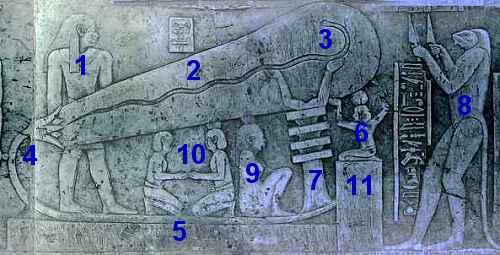![]() Electricity in
The Ancient World
Electricity in
The Ancient World
Electricity in Ancient Egypt and Rome
The Electric Mirror on the Pharos Lighthouse and Other Ancient Lighting
Ka: A Handbook of Mythology, Sacred Practices, Electrical Phenomena
puts forth the hypothesis that the ancients built electrical devices
that were utilized in religious ceremonies. With these "sacred fires"
these ancient priest/witch doctor/magicians mesmerized a primitive
audience of parishioners.
The Hebrew Ark of the Covenant , upon which YWHW was enthroned between two cherubim may also have been a powerful electrical capacitor.
"...the Name, the name of the LORD Almighty, who is enthroned between the cherubim that are on the ark." Louis Ginzberg’s "Legends of the Jews
" tells of ancient legends that refer to "sparks" emitted from the cherubim which comprised the lid/top of the Ark, as well as the positive and negative terminals. See: The Ark of the Covenant - A powerful Electrical Capacitor
In an underground cavern below the Hathor-temple in Dendera, Egypt there are several relief's depicting ancient devices, these controversial relief's are known as the Dendera lights. Two arms reach into its bulbous rounded end, these arms are supported by columns which are called Djed Pillars or Tet Columns, but very much resemble high voltage insulators. At the thin end of the Dendera lights runs something resembling a cable into the glass bulb. Extending the length of the glass bulb is a snake hanging horizontally in the air. The whole arrangement bears an striking resemblance to an electric lamp.
A Norwegian electrical engineer is credited as being the first
to notice that the objects shown on the relief could conceivably work as
a lamp, and an Austrian colleague constructed a working model.

Traditional Egyptologists claim that the relief's are of a religious / mythological nature. Traditional Egyptologists state that the Dendera lights are nothing more than a lotus flower, spawning a snake within.
Radical Egyptologists, as well as pseudo-scientists believe that they represent electric lamps.
I have several problems accepting the traditional interpretation . The stem of a lotus flower does not grow horizontally along the ground as in the relief , going off to a mysterious source, and then rise suddenly and vertically at 180° angle to connect to a mysterious bulbous form. As a matter of fact , in most cases the stem of the Lotus flower is not seen at all, it is submerged. A lotus flower does not require devices strangely resembling high voltage insulators to support their weight. Nor does a Lotus flower extrude a glass or transparent bulbous shape as in the relief.
* The Djed Pillars or Tet Columns which resemble electrical insulators appear frequently in Egyptian Glyphs Theoretically simplified, they represent stability . As theoretically utilized by the priesthood they stabilized the flow of current which the priests utilized in religious ceremonies.

Das Licht der Pharaonen. Hochtechnologie und elektrischer Strom im alten Ägypten. [not yet available in English]
- Priest
- ionized fumes
- electric discharge [snake]
- Lamp socket [Lotos]
- Cable [Lotos stem]
- Air god
- Insulator [Djed-Pillar]
- Light bringer [Thoth with knifes]
- Symbol for "current"
- Inverse polarity
- Energy storage
Some scholars have theorized that the Djed represented a cedar tree with its branches removed to which stalks of wheat were tied after harvest. In Snefru’s step pyramid, the Djed pillars form columns supporting the sky and may represent the four pillars which help Shu bear the sky on his shoulders. The Djed may also represent a man’s backbone. In the story of Isis and Osiris, the Djed pillar is Osiris’ backbone which Isis found buried in Djedu
During the Old Kingdom, the Djed was associated with the creator god of Memphis, who was given the epithet ‘the Noble Djed’. Later they became closely associated with Osiris .
Radical theorists , not discounting the traditional theories of its utility entirely, suggest that it acted not only in its symbolic status relative to Isis and Osiris - but that the Djed also functioned in a practical manner, utilized by the priesthood , as an electrical device.
Modern High Voltage Insulators
![]()
![]()
Djed Columns from Ancient Egypt
"Amulius, a descendant of Tibernius, displayed an overweening pride and dared to make himself a god; he went so far as to match the thunder with artificial thunder, to answer lightning with lightning and to hurl thunderbolts."
Electrical Ark of the Covenant
Alexander the Great UFO Encounters
Giants of Ancient America Midwest Mound Builders
Giants of Ancient America Southwest US & Mexico
Neanderthal and Nephilim the Same?
Caucasian Mummies in Ancient China
Hebrews and Egyptians in Ancient America